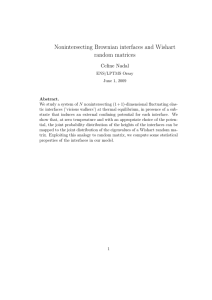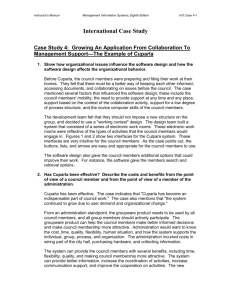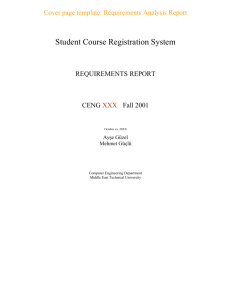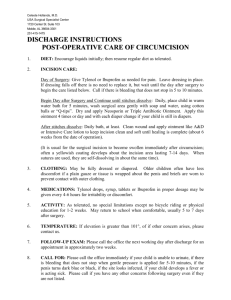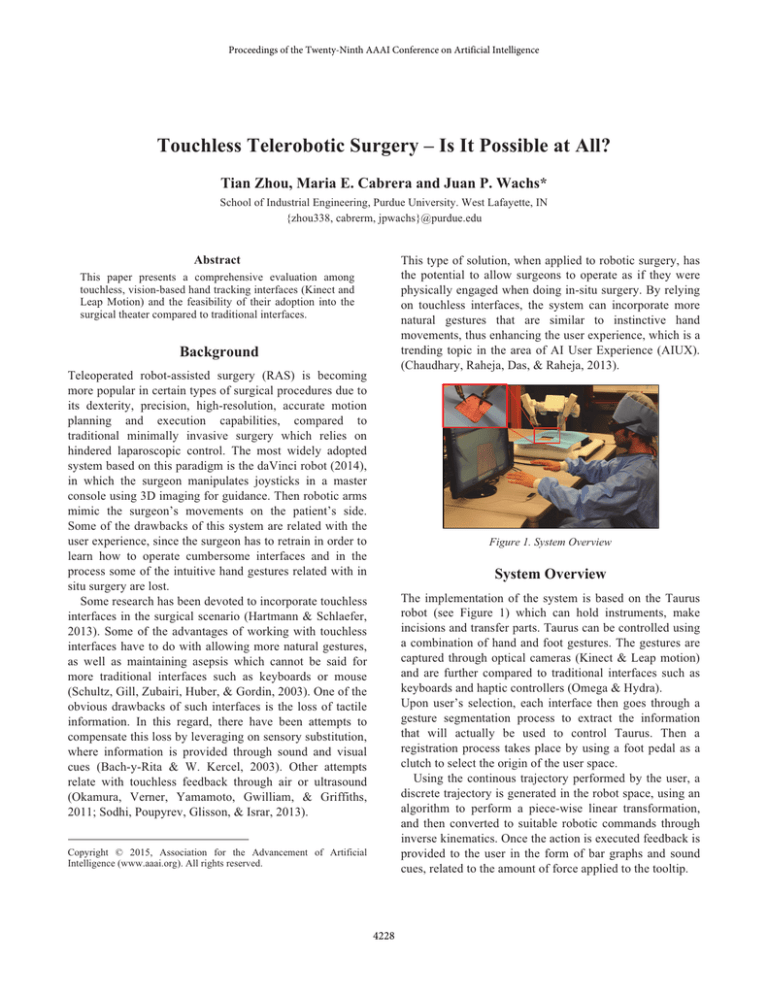
Proceedings of the Twenty-Ninth AAAI Conference on Artificial Intelligence
Touchless Telerobotic Surgery – Is It Possible at All?
Tian Zhou, Maria E. Cabrera and Juan P. Wachs*
School of Industrial Engineering, Purdue University. West Lafayette, IN
{zhou338, cabrerm, jpwachs}@purdue.edu
This type of solution, when applied to robotic surgery, has
the potential to allow surgeons to operate as if they were
physically engaged when doing in-situ surgery. By relying
on touchless interfaces, the system can incorporate more
natural gestures that are similar to instinctive hand
movements, thus enhancing the user experience, which is a
trending topic in the area of AI User Experience (AIUX).
(Chaudhary, Raheja, Das, & Raheja, 2013).
Abstract
This paper presents a comprehensive evaluation among
touchless, vision-based hand tracking interfaces (Kinect and
Leap Motion) and the feasibility of their adoption into the
surgical theater compared to traditional interfaces.
Background
Teleoperated robot-assisted surgery (RAS) is becoming
more popular in certain types of surgical procedures due to
its dexterity, precision, high-resolution, accurate motion
planning and execution capabilities, compared to
traditional minimally invasive surgery which relies on
hindered laparoscopic control. The most widely adopted
system based on this paradigm is the daVinci robot (2014),
in which the surgeon manipulates joysticks in a master
console using 3D imaging for guidance. Then robotic arms
mimic the surgeon’s movements on the patient’s side.
Some of the drawbacks of this system are related with the
user experience, since the surgeon has to retrain in order to
learn how to operate cumbersome interfaces and in the
process some of the intuitive hand gestures related with in
situ surgery are lost.
Some research has been devoted to incorporate touchless
interfaces in the surgical scenario (Hartmann & Schlaefer,
2013). Some of the advantages of working with touchless
interfaces have to do with allowing more natural gestures,
as well as maintaining asepsis which cannot be said for
more traditional interfaces such as keyboards or mouse
(Schultz, Gill, Zubairi, Huber, & Gordin, 2003). One of the
obvious drawbacks of such interfaces is the loss of tactile
information. In this regard, there have been attempts to
compensate this loss by leveraging on sensory substitution,
where information is provided through sound and visual
cues (Bach-y-Rita & W. Kercel, 2003). Other attempts
relate with touchless feedback through air or ultrasound
(Okamura, Verner, Yamamoto, Gwilliam, & Griffiths,
2011; Sodhi, Poupyrev, Glisson, & Israr, 2013).
Figure 1. System Overview
System Overview
The implementation of the system is based on the Taurus
robot (see Figure 1) which can hold instruments, make
incisions and transfer parts. Taurus can be controlled using
a combination of hand and foot gestures. The gestures are
captured through optical cameras (Kinect & Leap motion)
and are further compared to traditional interfaces such as
keyboards and haptic controllers (Omega & Hydra).
Upon user’s selection, each interface then goes through a
gesture segmentation process to extract the information
that will actually be used to control Taurus. Then a
registration process takes place by using a foot pedal as a
clutch to select the origin of the user space.
Using the continous trajectory performed by the user, a
discrete trajectory is generated in the robot space, using an
algorithm to perform a piece-wise linear transformation,
and then converted to suitable robotic commands through
inverse kinematics. Once the action is executed feedback is
provided to the user in the form of bar graphs and sound
cues, related to the amount of force applied to the tooltip.
Copyright © 2015, Association for the Advancement of Artificial
Intelligence (www.aaai.org). All rights reserved.
4228
actual trajectory. All those results are averaged to get the
deviation error per interface, as shown in Figure 3 (right).
In order to measure how well the users could maintain a
fixed depth, the variance of the depth trajectory was
analyzed. The average of all the trials indicates the depth
fluctuation per interface, as shown in Figure 4.
In the Peg Transfer Task, the metrics recorded and
analyzed were the task completion time and the number of
peg drops. A learning rate was calculated after fitting
learning curves to the completion time, shown in Table 1.
Figure 2. Left: Incision task. Right: Peg transfer task.
Conclusions
This paper presents a comparison between interfaces
developed for controlling a robot for surgical applications.
Experimental results reveal that for the incision task, Leap
Motion, keyboard and Omega interfaces exhibit less
deviation error from the target than that of using Hydra and
Kinect interfaces (p<0.001). For maintaining a fixed depth
during incision, the Kinect and keyboard interfaces
provided a more stable control (p<0.001) than the Omega,
Hydra and Leap Motion interfaces. Regarding the Peg
Transfer task, Omega and Hydra required shorter task
completion time than the Kinect, keyboard and Leap
Motion (p<0.001); On the other hand, touch-less interfaces
presented faster learning rate (69.86% for Leap Motion and
85.42% for Kinect) than their counterpart interfaces.
Figure 3. Deviation Error in the Incision Task
Figure 4. Depth Fluctuation in the Incision Task
TABLE 1. AVERAGE PERFORMANCE FOR THE PEG TRANSFER TASK
Interface
Hydra
Keyboard
Kinect
Leap Motion
Omega
Time ± CI (s)
107.9A ± 10.00
271.9B ± 37.33
594.7C ± 64.64
360.2B ± 70.98
121.3A ± 13.34
Peg Drops ± CI
0.2A ± 0.2
0.15A ± 0.2
0.4B ± 0.3
1.3B ± 0.6
0.2A ± 0.2
Learning Rate
92.71%
93.83%
85.42%
69.86%
85.69%
Acknowledgments
This publication was made possible partially by the NPRP
award (NPRP6-449-2-181) from Qatar National Research
Fund (member of The Qatar Foundation). The statements
made herein are solely the responsibility of the authors.
Experiments
Two experiments were conducted to measure the
performance of different interfaces through teleoperation.
Subjects used different interfaces to complete two surgical
tasks while several task-related metrics were measured and
further analyzed. The first task involved conducting a
guided surgical incision while maintaining a fixed depth.
The second task involved a Peg Transfer task common in
laparoscopic surgery skill assessment. Both tasks are
shown in Figure 2.
For the experimental design, ten engineering students
conducted this experiment (5 male, 5 female, average age
30.5). Each subject teleoperated Taurus using two out of
five interfaces, for five repetitions with each interface,
resulting in 20 observations for each interface. The order of
the two interfaces was randomized to compensate for the
learning of the task.
In the Incision Task, each trial was compared against a
reference line (Figure 3, left) by selecting twenty equally
spaced landmarks and finding the closest distance to the
References
Bach-y-Rita, P., & W. Kercel, S. (2003). Sensory substitution and
the human–machine interface, 7(12), 541–546.
Chaudhary, et. al.(2011). Intelligent Approaches to interact with
Machines using Hand Gesture Recognition in Natural way: A
Survey. IJCSES Vol 2, No.1, 122-133
da Vinci Surgery - Minimally Invasive Robotic Surgery. (2014).
Retrieved April 19, 2014, from http://www.davincisurgery.com/
Hartmann, F., & Schlaefer, A. (2013). Feasibility of touch-less
control of operating room lights, 8(2), 259–268.
Okamura, A. M., et. al. (2011). Force Feedback and Sensory
Substitution for Robot-Assisted Surgery. Surgical Robotics (pp.
419–448).
Schultz, M., et. al. (2003). Bacterial contamination of computer
keyboards in a teaching hospital, 24(4), 302–303.
Sodhi, R., et. al. (2013). AIREAL: Interactive Tactile Experiences
in Free Air, 32(4), 134:1–134:10
4229


